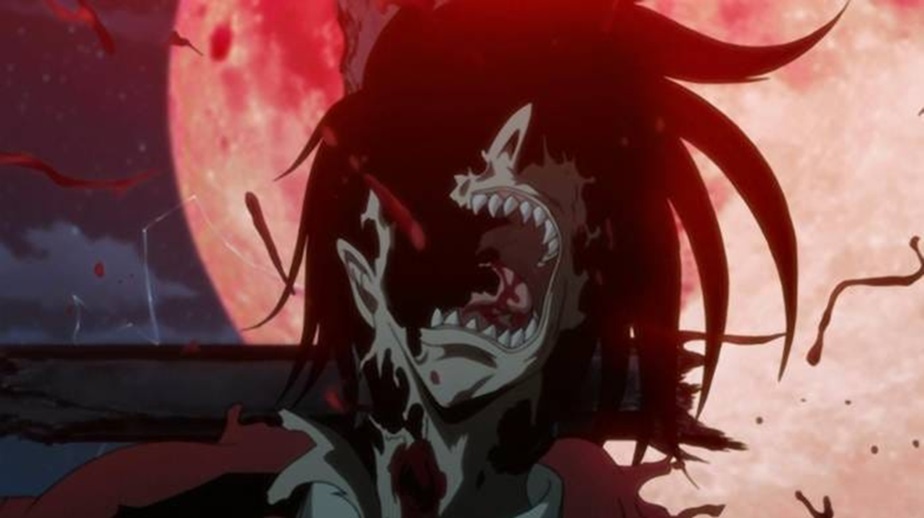Anxiety occurs when we send out a ‘robot-self’ into the world to do some sort of task and that robot self gets cut off from its source (somehow) and so has to carry on by itself!
There is a little bit more we could say about this of course – we send a robot-self out into the world to do a job for us it is true, but more than that we attach a portion of our awareness to it to accompany it wherever it goes. This is a type of experiment that we are making, in other words – we’re sending out a mechanical probe which our awareness has somehow got ‘caught up in’, or ‘entangled with’. The robot-self is no more than a collection of reflexes (or automatic responses) but we experience it as being ‘the whole of everything we could ever be’. We’re stuck in the encapsulated self on a full time basis in other words, and this is a perfect recipe for anxiety. We’ve put ourselves in an untenable situation and yet – at the same time – we don’t realize it.
Although we have been placed – via our identification with the bundle of mechanical reflexes that are all we’ve got to go on – in an untenable position we don’t notice this fact straightaway. We don’t notice this fact straightaway because we’re deluded. The nature of our delusion is that we aren’t merely a bundle of mechanical reflexes, that we are actually a lot more than just this. We experience ourselves as being free agents fully capable of autonomous action in the world. We experience ourselves as being ‘complete in ourselves’ when this is very far from being the case. We experience ourselves as being ‘up to the job’…
Just as long as this illusion holds good therefore we will continue to feel confident and buoyant – it’s a confidence without any basis to be sure but just so long as we don’t know this we will continue to feel able to do whatever it is that we need to do. We imagine ourselves to have ‘the power to do’ and this feels good to us. As G. I. Gurdjieff says however, we don’t have the power to do when we are asleep any more than we have the power to be – being asleep means precisely that we only imagine we can do and be. We can only do and be in our dream, and the dream is not real. This is our fantasy and we won’t let anyone tell us otherwise but how can we say that we can do and be when we don’t know who we really are, when our situation is that we have mistakenly identified ourselves with a bundle of automatic reflexes?
When we identify with a mechanic reflex (or ‘impulse’) then we claim the power of volition, the power of effective action. We go along with the impulse and say that it is our own volition, our own intention. If the impulse achieves the outcome we want then we lay claim to this outcome too, and feel satisfaction on this account. We take the glory when the glory is not really ours! Actually, there was no glory – the mechanical impulse was merely doing was it does because it had no choice about it, that being the nature of mechanical actions…
Doing – needless to say – is not the same as the same as ‘letting ourselves be carried along by the wave of a mechanical impulse whilst claiming to be walking on our own two feet’. Doing comes from within, not from something outside of us that we hitch a ride with. The confidence that we gain as a result of hitching a ride with a mechanical impulse and then fooling ourselves into believing that we are the one who is calling the shots is hardly going to be a very reliable friend therefore; we might perceive ourselves to be cruising through life in a relaxed and confident way but this perception is an illusion – it’s only a matter of time before things start to come undone and the ‘cruise’ turns into a nose-dive. The euphoric sense of buoyancy that we felt about being ‘the effective controller’ is due to be painfully reversed when this mistaken view is rudely snatched away from us again, as it is absolutely bound to be at some point in the proceedings. We were hardly going to be able to hang to this comfortable illusion forever!
Mechanical movements always reverse themselves. It’s like a planet moving around the sun or the moon moving around the earth – there seems to be change (or ‘progress’ going on) but really it’s just a ‘never-ending reversal’. It is non-change disguised as change. It’s a type of movement that always comes back on itself in the end and a type of movement that always comes back on itself in the end isn’t movement. This being the case, we might ask, what then gives rise to genuine change – change that doesn’t reverse itself later on? The simple answer is that only the Whole, acting as the Whole, can give rise to genuine change. We can understand this by looking at rules, as opposed to ‘spontaneous change’. When the Whole is broken up into competing fragments (i.e. ‘rules’) then all that can ever come about as a result of acting out these rules is circular movement, or ‘closed movement’ (if we may call it that). Naturally enough, rules can never cause change – a rule is a fixed thing and so it can only ever give rise to ‘movement’ that takes place within fixed parameters. The rule is itself by its very nature a fixed (or ‘defined’) parameter – it’s something that we can’t ever go beyond’.
Genuine movement, on the other hand, has nothing whatsoever to do with rules. There is no rule for change! This becomes obvious just as soon as we say it – how can movement (or change) be predicated upon a rule when a rule is ‘something that we can’t ever go beyond’? Real movement has to do with that situation in which there are no limits, in which there are no ‘things we cannot go beyond’. This situation, as vague and mysterious as it may sound, is simply ‘the Whole’ – in one way the Whole of Everything is very mysterious, to be sure, but at the same time it can hardly be denied that there is such a thing! How could there possibly not be such a thing as ‘the Whole of Everything’? ‘The Whole’ is simply that from which nothing is excluded – we don’t therefore have to concern ourselves obsessively over what exactly it is that has not been excluded (or with what the Whole is or is not, which would be a thoroughly meaningless question to ask anyway) but content ourselves merely to note that wherever the Whole is involved then genuine (i.e. non-rule-based) movement is possible…
When the Whole is not involved then, as we have said, movement-that-is-worthy-of-the-name-of-movement is not possible – it’s not possible for the very simple reason that we can’t in this case ever go beyond our limiting assumptions! This is of course very clear when we reflect on it – how can there be genuine movement or change when the Whole has been kept out of the picture, which is what the rational mind always does? When the Whole has been excluded then we know that not only can there not be any real movement or change, we also know that there can’t be anything since the Whole can’t ever be truly excluded. The Whole can’t ever be split up or divided – we can it is true look at it in funny ways that makes it seem to us that it has been but that is entirely our own delusion! When we look at reality in a partial or filtered way (and create as a result abstract or ‘toy’ universes for ourselves to play around with) then what we produce is the situation that is made up of fragments that don’t declare themselves to be fragments, ‘fractions which hubristically imagine themselves to be whole numbers (to echo what Joseph Campbell has said). Such a ‘fraction’ is the conditioned sense of self, the bundle of mechanical reflexes that we have unwittingly thrown our lot in with. On this provisional basis not only are our actions very strictly curtailed, but so too is our ability to see the world…
When we’re looking at the world through the lens of the rational mind then the conditioned view is all that we have – this is the only view that we ever can have from the POV of the bundle of mechanical reflexes (or rules) and so the conditioned view becomes ‘the only possible view’. When we live the life of the robot self (i.e. ‘the-self-which-is-only-a-reflex’ then we’re limited without knowing that we’re limited and it is precisely this situation that sets us up to be anxious.
The robot self, as we have said, is simply not capable of dealing with its situation, dealing with the open-ended universe that it has been sent out into. How could it be? It exists in a world which it denies – or as we could also say, it denies the world so that it can exist! This fractional version of ourselves can only continue to exist when it perceives the world to be only what it says it is, only what it believes it is. Any mismatch between its fundamental assumptions about what reality is and what reality actually shows itself as being results in the potentially fatal destabilization of the self-construct and so has to be ‘corrected’ immediately. We can have any radical uncertainty in the mix, we can’t acknowledge the existence of ‘the radical other’ without at the same time having to say goodbye to the self-concept, which is the same thing as ‘the robot self’. If the concrete self were to acknowledge radical uncertainty (or ‘the radical other’) then it would be instantly ‘relativized’ which would mean of course that it would no longer be ‘concrete’. The self has to be literally understood – the self cannot be made ‘only relatively true’ (i.e. true only with regard to its own arbitrary assumptions) without it immediately ceasing to be ‘the self’!
The relativized self (the ‘self that doesn’t take itself seriously’) couldn’t be prey to anxiety anymore but neither would it still be ‘the self’ and so on one level (the only level that matters, as far as the self is concerned!) this constitutes a loss. This is – admittedly – a very superficial level but – nevertheless – it is the only level that the self knows or can know. The ‘choice’ is therefore that we can have the self and its anxiety, or we lose the self and don’t on this account have to suffer from this particular curse any more. The problem is however that we are flatly incapable of understanding that we aren’t the robot self, and that what we are doesn’t have to experience itself in this way. We have become fundamentally disconnected from who we really are, as we said at the start of this discussion, and so the option of ‘giving up’ the self just doesn’t exist for us.
It’s not that the self is anxious all the time, as we have said – half the time we get to enjoy the ‘false confidence’ that comes with believing that the tailor-made pseudo-world it perceives (which is if the truth were to be known only the faithful reflection of its own limiting assumptions) is the only world there is, the ‘one and only true world’. Within this limited setting – which is not challenging us in any serious way, no matter what troubles might seem to be coming along – we will feel quite content, we will feel perfectly adequate to the situation that is being presented to us. What is happening here is that we have oversimplified reality and as a result of this cheat we appear to have ‘got something for nothing’. We have obtained a ‘pay-off’, in other words, and the pay-off is that we get to ride the wave of false confidence as far as it will take us. This is the $200 that we collect when we pass ‘GO’; this is the kick-start that sends us on our way. We then find ourselves playing the game in earnest and this is when we learn – eventually – that all ‘movement’ in a logical continuum is circular movement. Really, what we did in order to avail of the ‘bonus payment’ was that we made ourselves dumb, and the downside of this tactic is that when we make ourselves dumb then we become dumb! Dumb’s not quite the word we want here – although it’s close enough – what we’re actually doing here in this type of dumbness is fooling ourselves into thinking that the world is a smaller place than it really is. This way we get to be ‘a big fish in a small pond’, this way we get to ‘reify our idea of ourselves’.
One side of fooling ourselves into thinking that the world is a smaller place than it really is this phenomenon of ‘hubris’ or ‘false confidence’; the other side however is a type of nameless terror that we now have (without consciously being aware of it) in relation to the vastly more expansive (and therefore vastly challenging) world that we know, on some deep level, to be out there. Hubris and anxiety go together therefore – which is very obvious when we reflect on it! Hubris is really just ‘repressed fear’ and ‘repressed fear’ is just another way of talking about anxiety. When we are successful in the operation of repressing fear then we experience euphoria (i.e. ‘false confidence’) and when – as it must – the repressed fear starts to show itself in unsuspected quarters then this is anxiety. The euphoria is the ‘reified self’ and so is the dysphoria which is the anxiety.
We can think of this mechanism – the mechanism by which the reified or ‘disconnected robot self’ is created – as being essentially the same sort of thing as the process by which a bump is produced on a flat surface by ‘elevating one portion of the surface at the expense of all the rest’. The viewpoint of the reified self is emphasized so that it becomes our only possible way of seeing the world and everything else (i.e. the ‘flat surface’, which is the unacknowledged source of that self) is thrust out of sight, repressed, rendered unconscious, etc. If we had to say what this flat surface is in our metaphor we could say that it is the underlying medium of consciousness which has to be denied so that the robot self can have its (apparently) autonomous life!
What could be easier to understand than this, we might ask? Although we might also, with equal validity, ask ‘What could be harder to understand than this?’ What we have just said is not just hard to understand (from the point of view of the reified self), it is impossible – we have after all denuded ourselves of the ability to see what is going on at the same time we took up this viewpoint. ‘Losing sight of what’s going on’ is the way we become the positive or reified self. When it comes to ‘being conscious’ therefore we’re in a bit of quandary because – as we keep saying – the self only gets to be the self by getting rid of consciousness. So although we think that we are conscious in everyday life, what we’re actually talking about here is a particular form of consciousness that isn’t actually consciousness at all but an inverted analogue of it, a kind of upside-down reflection of it. We’re conscious only of what the rules (our ‘conditioning’) lets us be conscious of; we’re conscious only of the groundless delusions that we are compelled by our conditioning to perceive as real, so in what way can this be called ‘being conscious’?
Another way of approaching this idea of the inverted analogue is to look at it in terms of freedom – freedom can appear in its reversed form of negative freedom (as John G. Bennett puts it) which is where ‘we are free to do only what the rules tell us to do’. This is freedom too because we are free to do it, even though when everything about us is conditioned or determined by rules this is actually the very antithesis of freedom! Although freedom is all there is, freedom also facilitates us to live in a way that is completely devoid of freedom, and the result of this type of ‘unfree life’ is euphoria on the one hand, and dysphoria on the other. Such is everyday life – which is the life of the reified self – a mixture of self-balancing hubris and anxiety! This – we might say – is the result of the experiment that we have made in sending out the robot self all on its own into a world that it has to deny in order to continue existing as ‘the robot self that cannot see itself to be only a robot’. The first step (so to speak) in ‘re-establishing our link with consciousness’ – which is our denied source – is to see the true (machine-like) nature of this robot self. This means observing that it is indeed ‘a robot self’, which is to say, observing that it has no freedom….!






